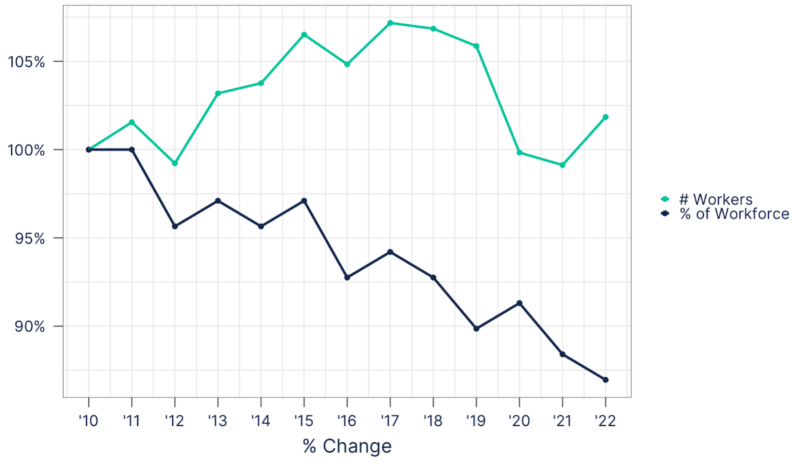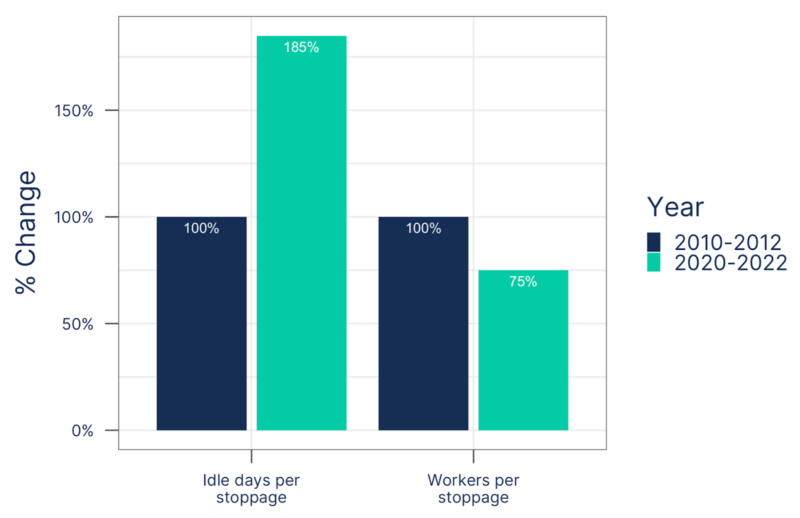Exploring the dynamics of unionization and frontline worker sentiment
December 21, 2023
Unionization rates in the United States have been relatively low for several decades. Whether this is the result of ideological, cultural, or economic shifts; the Small Business & Entrepreneurship Council highlights a significant decline in labor union membership over the past 40 years.
While the overall union membership rate in the country remains lower compared to previous decades, unionization in the United States has seen some revitalization in recent years, with a notable increase in labor activism, particularly in sectors like tech and gig economy work.
Supporting this theory, a 2023 Gallup poll states that public support for labor unions has been on the rise, with 71% of Americans approving unions, the highest since 1965. This rise can be attributed to various factors, including growing income inequality, concerns about worker rights, and the high-profile labor disputes which often gain attention on social media platforms where grassroots activism and digital campaigns go viral. For the first time ever, a sitting president joined a U.A.W picket line in support of unions, playing a significant role in shaping public sentiment.
Despite the rising popularity of unions in the media, union membership count has remained relatively stable and is decreasing as a percentage of total workforce. In fact, the percentage of union members across manufacturing, transportation and warehousing are decreasing even more.
So, while public sentiment towards unions is increasingly positive, as evidenced by the 2023 Gallup poll, this hasn’t directly translated into a surge in union membership. The disconnect between public approval and actual membership rates presents a complex picture of the current labor landscape. Moreover, the decline in unionization within traditional strongholds like manufacturing, transportation, and warehousing adds another layer of complexity.
This contrast between perception and reality, coupled with the diverse experiences of thousands of frontline workers as revealed in WorkStep’s comprehensive data, invites a deeper examination. We aim to delve into these nuances, exploring the evolving dynamics of unionization in the United States with a look ahead to the future.
2023: The year of the strike
It’s true that there have been more work days lost to strikes in 2023 than any year in two decades. This is due to a confluence of factors that have fueled labor strikes and walkouts. Strikes were so prevalent in 2023, that news organizations and pundits have deemed 2023 the year of the strike.
Here are some other key union trends and events from we’ve seen in 2023:
- Gig workers: Some states have passed legislation to classify gig workers as employees rather than independent contractors, which can make it easier for them to unionize and push for better working conditions, job security, and benefits
- Amazon warehouse workers: Amazon has been a focal point of labor organizing efforts, with frontline workers seeking better wages and working conditions alongside high-profile unionization votes, like one in Bessemer, Alabama, where voters rejected a union for the second time.
- Healthcare workers: Healthcare workers, especially those on the front lines during the COVID-19 pandemic, have been actively advocating for better wages, benefits, and workplace safety measures.
The pandemic had a significant impact on worker mentalities and expectations in the United States. COVID-19 highlighted the importance of workplace safety, especially for essential workers, where many employees became more conscious of their health and safety. This has led to increased demands for protective equipment, sanitation measures, and remote work options where possible.
Essential workers, such as healthcare professionals, grocery store employees, and delivery drivers, received more recognition for their contributions, but led to calls for better compensation and benefits as they settled into their “new normal.”
As we’ve seen in 2023, the surge in labor strikes and the increased activism among various worker groups, reflect a growing consciousness about workers’ rights and conditions. These developments, however, are just the surface of a much deeper current in the labor force. Moving from the broader landscape of labor activism to a more focused lens, we now turn to the sentiments of frontline workers themselves. Let’s delve into WorkStep’s comprehensive data collected from these workers, which offers a unique perspective on how the individuals at the heart of these movements perceive and interact with unions.
Union sentiment of frontline workers
Frontline workers play a crucial role in any industry, and their perspectives on unions provide valuable insights into the evolving dynamics of labor representation and workplace satisfaction. WorkStep’s data analysis reveals a noteworthy relationship between positive union sentiment and elevated concerns among frontline workers in three key areas:
- Pay: Employees with positive union sentiment express heightened concerns about their compensation. This phenomenon may stem from expectations of unions to negotiate for better wages and benefits on behalf of their members, which indicates these workers may view unions as instrumental in addressing their financial well-being.
- Career Growth: Frontline workers who hold positive views of unions also tend to express concerns about career growth within their organizations. This suggests that they may look to unions as advocates for opportunities for advancement and skill development as they seek both job security and pathways for professional growth.
- Manager Relationships: Employees with positive union sentiment frequently mention concerns related to manager relationships. This could be attributed to the expectation that unions play a role in mediating disputes, improving the manager-employee dynamic, and ensuring they are treated fairly and respectfully by their supervisors.
WorkStep’s data sheds light on the intricate relationship between union sentiment and the concerns of frontline workers. While positive union sentiment often corresponds to elevated concerns around a few key areas, the data underscores the complexity of union dynamics in the modern workplace and the need for organizations to carefully consider and address the concerns of their frontline workforce.
The insights gleaned from WorkStep’s data not only highlight the diverse attitudes of frontline workers towards unions but also underscore the broader theme of worker engagement and representation. As we’ve seen, positive union sentiment often correlates with concerns over pay, career growth, and manager relationships. These factors are indicative of a fundamental need: workers’ desire to be heard and acknowledged.
Shifting our focus to 2024, we anticipate a year where addressing these needs becomes paramount for organizations.
Tune into your frontline with WorkStep
With the frontline employee engagement platform that delivers the real-time insights you need to take action, retain your workforce, and drive your business forward.
2024: The year of making frontline workers feel heard
No matter the political, social, or economic climate; no matter the public’s union sentiment; one thing remains constant: employees want to feel heard. From the company’s perspective, the loss of productivity from strikes hurts both the employees and the organization and being able to directly address employees’ concerns can ensure that employees build trust and loyalty to the organization.
Labor unions have become more active and strategic in their organizing efforts. They have leveraged digital communication and social media platforms to mobilize workers, raise awareness of labor issues, and coordinate strikes more effectively. These technological advances have also made it easier for HR and Operations leaders to empower their frontline workforce.
Employee engagement software, like WorkStep, can help leaders tune into their frontline and ensure their employees are both feeling heard and valued and help organizations demonstrate that their employee concerns are being addressed.
As the leading frontline employee engagement platform, we have found that workers are more than willing to express their concerns to leadership so workplace issues can be solved internally. All organizations have to do is commit to collecting feedback.
For the high percentage of the frontline workforce that’s not unionized, WorkStep is an essential tool to help amplify and elevate worker concerns. WorkStep helps organizations mitigate concerns around pay, career growth and favoritism in the workplace by listening to the concerns of those on the frontline, to get ahead of issues before they arise. Our milestone, one-time, and annual engagement surveys are designed with common frontline problems in mind.
For frontline workforces that are unionized, WorkStep provides additional avenues to help companies understand employee concerns and the tools to address them directly or in conjunction with the union. WorkStep helps equip site leaders with the means to identify, strategize for, and resolve workplace issues internally before a decline in employee sentiment becomes a concern.
By staying on top of the latest trending topics, analyzing and sharing the data with executive leaders, and closing the loop with employees, organizations can quell dissatisfaction before issues escalate. Nobody wants to go to work and be stressed by factors outside of their control, that’s a simple human truth that extends from the semi-truck driver, through the warehouse, all the way to senior management. Likewise, no employer wants to have a poor reputation in their community. The internal solution has been there all along – building a best in class workplace begins with a better relationship with your employees.
Tom Goyette, Product Marketing Manager | tom.goyette@workstep.com
Tom Goyette is a Product Marketing Manager at WorkStep. With experience in start-up and enterprise level SaaS and eCommerce organizations, Tom excels at managing and creating content, marketing, and analytics. Tom believes people are at the center of every great organization and is eager to share stories that highlights the value of the employee voice.





